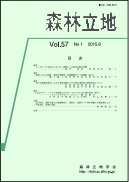Current issue
Displaying 1-12 of 12 articles from this issue
- |<
- <
- 1
- >
- >|
-
2025Volume 67Issue 1 Pages cover1-
Published: June 25, 2025
Released on J-STAGE: July 23, 2025
Download PDF (261K) -
2025Volume 67Issue 1 Pages app1-
Published: June 25, 2025
Released on J-STAGE: July 23, 2025
Download PDF (230K) -
2025Volume 67Issue 1 Pages app2-
Published: June 25, 2025
Released on J-STAGE: July 23, 2025
Download PDF (81K)
Document
-
Article type: Document
2025Volume 67Issue 1 Pages 1-3
Published: June 25, 2025
Released on J-STAGE: July 23, 2025
Download PDF (2302K) -
Article type: Document
2025Volume 67Issue 1 Pages 5-9
Published: June 25, 2025
Released on J-STAGE: July 23, 2025
Download PDF (1024K) -
Article type: Document
2025Volume 67Issue 1 Pages 11-17
Published: June 25, 2025
Released on J-STAGE: July 23, 2025
Download PDF (8034K)
Record
-
Article type: Record
2025Volume 67Issue 1 Pages 19-23
Published: June 25, 2025
Released on J-STAGE: July 23, 2025
Download PDF (9188K)
-
2025Volume 67Issue 1 Pages 24-29
Published: June 25, 2025
Released on J-STAGE: July 23, 2025
Download PDF (616K) -
2025Volume 67Issue 1 Pages 30-32
Published: June 25, 2025
Released on J-STAGE: July 23, 2025
Download PDF (271K) -
2025Volume 67Issue 1 Pages 33
Published: June 25, 2025
Released on J-STAGE: July 23, 2025
Download PDF (72K) -
2025Volume 67Issue 1 Pages app3-
Published: June 25, 2025
Released on J-STAGE: July 23, 2025
Download PDF (232K) -
2025Volume 67Issue 1 Pages cover2-
Published: June 25, 2025
Released on J-STAGE: July 23, 2025
Download PDF (272K)
- |<
- <
- 1
- >
- >|
